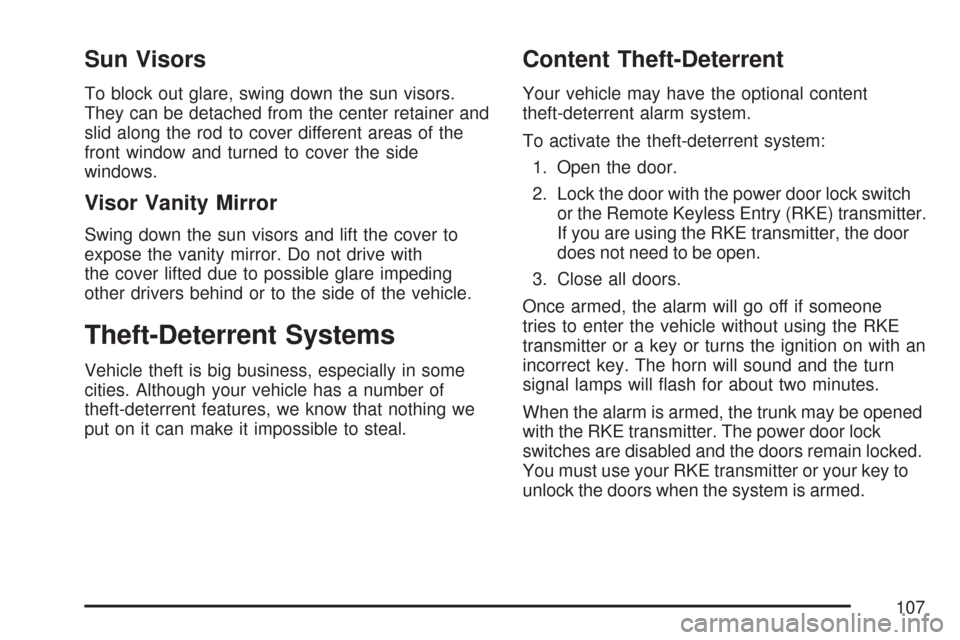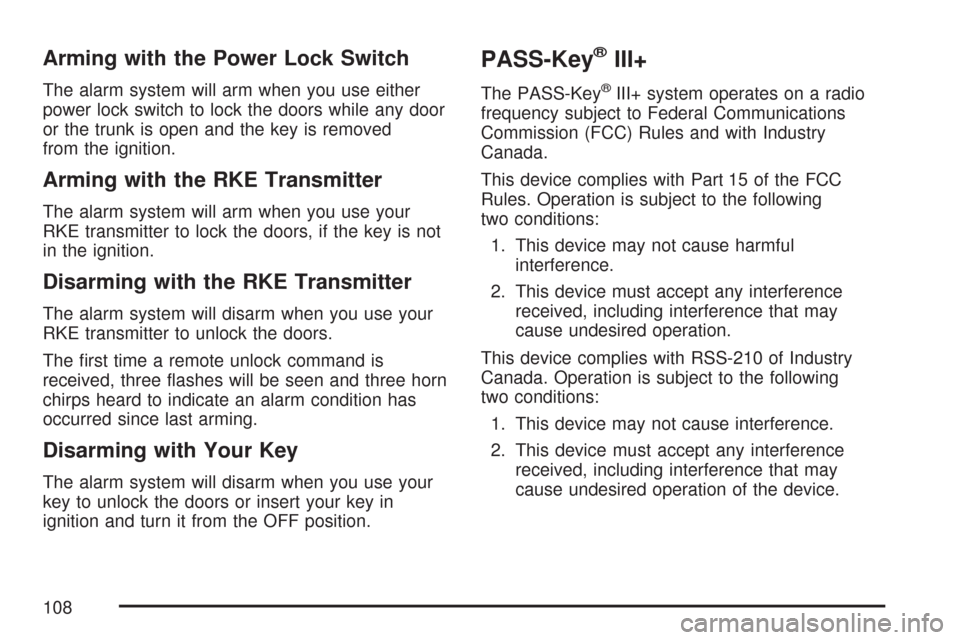Page 93 of 460

V(Remote Trunk Release):Press and hold
this button for about one second to release
the trunk lid. The transaxle must be in PARK (P)
for this feature to operate.
L(Vehicle Locator/Panic Alarm):Press and
release this button to locate your vehicle. The turn
signal lamps will �ash and the horn will sound
three times. Press and hold this button for more
than two seconds to activate the panic alarm.
The turn signal lamps will �ash and the horn will
sound repeatedly for 30 seconds. The alarm
will turn off when the ignition is turned to RUN or
the alarm button is pressed again. The ignition
must be in OFF for the panic alarm to work.
Matching Transmitter(s) to Your
Vehicle
Each remote keyless entry transmitter is coded
to prevent another transmitter from unlocking
your vehicle. If a transmitter is lost or stolen,
a replacement can be purchased through your
GM dealer. Remember to bring any additional
transmitters so they can also be re-coded to match
the new transmitter. Once your dealer has coded
the new transmitter, the lost transmitter will not
unlock your vehicle. The vehicle can have a
maximum of eight transmitters matched to it.
See Remote Key underDIC Operation and
Displays on page 191.
93
Page 107 of 460

Sun Visors
To block out glare, swing down the sun visors.
They can be detached from the center retainer and
slid along the rod to cover different areas of the
front window and turned to cover the side
windows.
Visor Vanity Mirror
Swing down the sun visors and lift the cover to
expose the vanity mirror. Do not drive with
the cover lifted due to possible glare impeding
other drivers behind or to the side of the vehicle.
Theft-Deterrent Systems
Vehicle theft is big business, especially in some
cities. Although your vehicle has a number of
theft-deterrent features, we know that nothing we
put on it can make it impossible to steal.
Content Theft-Deterrent
Your vehicle may have the optional content
theft-deterrent alarm system.
To activate the theft-deterrent system:
1. Open the door.
2. Lock the door with the power door lock switch
or the Remote Keyless Entry (RKE) transmitter.
If you are using the RKE transmitter, the door
does not need to be open.
3. Close all doors.
Once armed, the alarm will go off if someone
tries to enter the vehicle without using the RKE
transmitter or a key or turns the ignition on with an
incorrect key. The horn will sound and the turn
signal lamps will �ash for about two minutes.
When the alarm is armed, the trunk may be opened
with the RKE transmitter. The power door lock
switches are disabled and the doors remain locked.
You must use your RKE transmitter or your key to
unlock the doors when the system is armed.
107
Page 108 of 460

Arming with the Power Lock Switch
The alarm system will arm when you use either
power lock switch to lock the doors while any door
or the trunk is open and the key is removed
from the ignition.
Arming with the RKE Transmitter
The alarm system will arm when you use your
RKE transmitter to lock the doors, if the key is not
in the ignition.
Disarming with the RKE Transmitter
The alarm system will disarm when you use your
RKE transmitter to unlock the doors.
The �rst time a remote unlock command is
received, three �ashes will be seen and three horn
chirps heard to indicate an alarm condition has
occurred since last arming.
Disarming with Your Key
The alarm system will disarm when you use your
key to unlock the doors or insert your key in
ignition and turn it from the OFF position.
PASS-Key®III+
The PASS-Key®III+ system operates on a radio
frequency subject to Federal Communications
Commission (FCC) Rules and with Industry
Canada.
This device complies with Part 15 of the FCC
Rules. Operation is subject to the following
two conditions:
1. This device may not cause harmful
interference.
2. This device must accept any interference
received, including interference that may
cause undesired operation.
This device complies with RSS-210 of Industry
Canada. Operation is subject to the following
two conditions:
1. This device may not cause interference.
2. This device must accept any interference
received, including interference that may
cause undesired operation of the device.
108
Page 174 of 460

Warning Lights, Gages, and
Indicators
This part describes the warning lights and
gages on your vehicle. The pictures help to
locate them.
Warning lights and gages can signal that
something is wrong before it becomes serious
enough to cause an expensive repair or
replacement. Paying attention to the warning lights
and gages could also save you or others from
injury.
Warning lights come on when there may be or
is a problem with one of your vehicle’s functions.
As the details show on the next few pages,
some warning lights come on brie�y when you
start the engine just to let you know they are
working. If you are familiar with this section,
you should not be alarmed when this happens.Gages can indicate when there may be or is a
problem with one of your vehicle’s functions. Often
gages and warning lights work together to let you
know when there is a problem with your vehicle.
When one of the warning lights comes on and
stays on as you are driving, or when one of the
gages shows there may be a problem, check
the section that tells you what to do about
it. Please follow this manual’s advice. Waiting to
do repairs can be costly and even dangerous.
So please get to know your vehicle’s warning lights
and gages. They can be a big help.
Your vehicle may also have a Driver Information
Center (DIC) that works along with the warning
lights and gages. SeeDriver Information
Center (DIC) on page 190for more information.
174